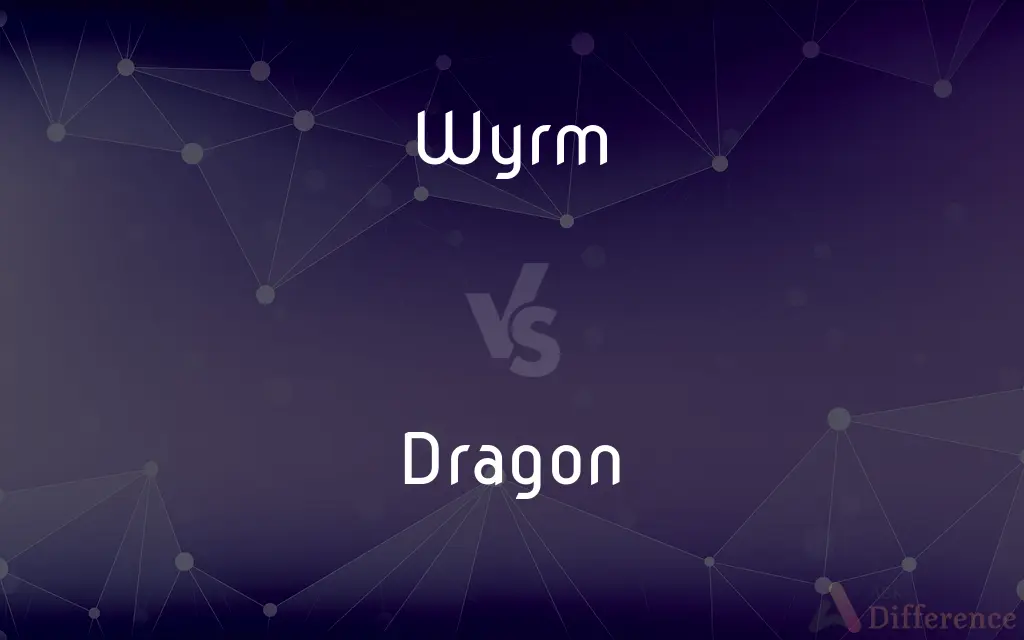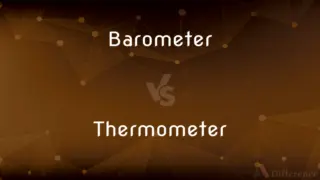Wyrm vs. Dragon — What's the Difference?
By Maham Liaqat & Fiza Rafique — Updated on February 23, 2024
A wyrm is a type of dragon often depicted as a large, serpent-like creature without wings or legs, while dragons are mythological beings with various forms, typically featuring wings and legs.

Difference Between Wyrm and Dragon
Table of Contents
ADVERTISEMENT
Key Differences
Wyrms and dragons occupy prominent places in the pantheon of mythological creatures, captivating the human imagination across various cultures and epochs. While both entities share a draconic lineage, their physical characteristics and symbolic representations often diverge. Dragons, as traditionally depicted, are powerful, majestic creatures with wings and legs, capable of flight and breathing fire. Their image is widespread, from the fire-breathing dragons of European folklore to the celestial, benevolent dragons of Asian traditions. Dragons embody a multitude of characteristics, including wisdom, power, and malevolence, depending on the cultural context from which they arise.
Wyrms are described as large, serpent like beings, emphasizing their legless and often wingless form. This depiction roots them more deeply in the realm of the earthbound and primal, drawing a stark contrast to the more versatile and aerial dragons. The wyrm's serpentine body echoes ancient symbols of the earth, fertility, and the underworld, painting them as creatures of the deep, whether that be the depths of the sea, the earth, or a dark cavern.
The differentiation in physical attributes between wyrms and dragons is reflective of the diverse roles they play within mythology and folklore. Dragons often hold roles of guardianship, wisdom, and destruction, their ability to fly and command fire positioning them as beings of both celestial and infernal nature. In contrast, wyrms, with their closer association to the earth and water, frequently appear as guardians of treasures, omens of doom, or embodiments of curses and destruction. Their portrayal taps into the primal fears and reverence humanity holds for the natural world's unseen and unfathomable depths.
The cultural significance of wyrms and dragons further illustrates the varied tapestry of human belief and storytelling. While dragons have been revered as symbols of power and protection in many Eastern cultures, they have also been feared as malevolent forces in Western narratives.
Both wyrms and dragons continue to be enduring figures in modern fantasy, literature, and popular culture, their legacy preserved and transformed by each new generation of storytellers. Whether depicted as noble beasts soaring through the skies or as sinister serpents dwelling in the dark, these creatures serve as a testament to the human fascination with the mythical and the monstrous. Through their stories, wyrms and dragons challenge heroes, inspire adventurers, and remind us of the boundless creativity and depth of human imagination in conceptualizing the unknown.
ADVERTISEMENT
Comparison Chart
Physical Characteristics
Large, serpent-like, often legless and wingless.
Varied forms, typically with wings and legs, capable of flight.
Symbolism
Primal, earthbound, associated with the earth, sea, or underworld.
Power, wisdom, malevolence, celestial or infernal aspects, depending on culture.
Abilities
May or may not breathe fire, possesses other magical powers.
Often breathes fire, has significant physical strength and magical abilities.
Role in Mythology
Guardians of treasures, omens of doom, embodiments of curses.
Guardians, symbols of wisdom or destruction, celestial beings.
Cultural Significance
Embodies natural and primal fears, trials, and tribulations.
Revered or feared as powerful entities, symbols of protection or malevolence.
Compare with Definitions
Wyrm
A type of dragon that embodies the primal and serpentine, lacking the traditional draconic features like wings, and often involved in tales of destruction or guardianship of sacred places.
Legends tell of a wyrm that sleeps beneath the castle, cursing the land with its mere presence.
Dragon
A symbol of auspicious power, strength, and good luck, depicted as a serpentine creature without wings, capable of controlling water and weather.
The dragon dance was performed to welcome prosperity and good fortune in the new year.
Wyrm
A creature from myth, symbolizing the dangers and mysteries of the natural world, often serving as a formidable adversary in heroic quests or as a guardian of untold secrets.
The hero's journey led him to confront the wyrm in its underwater lair, a test of courage and strength.
Dragon
A dragon is a large, serpentine, legendary creature that appears in the folklore of many cultures worldwide. Beliefs about dragons vary considerably through regions, but dragons in western cultures since the High Middle Ages have often been depicted as winged, horned, four-legged, and capable of breathing fire.
Wyrm
A mythological creature resembling a giant serpent, often depicted without legs or wings, associated with earth and water elements, and appearing in various folklore and fantasy stories.
The ancient wyrm guarded the lost treasure buried deep beneath the mountain.
Dragon
In Western mythology, a gigantic beast, typically reptilian with leathery bat-like wings, lion-like claws, scaly skin and a serpent-like body, often a monster with fiery breath.
Wyrm
A term used in fantasy literature and games to describe a dragon-like being, focusing on its more primitive, serpentine qualities rather than the majestic and powerful aspects of traditional dragons.
The adventurers prepared to face the wyrm, a creature said to possess ancient magic and knowledge.
Dragon
A fabulous winged creature, sometimes borne as a charge in a coat of arms.
Wyrm
A representation of chaos and destruction, often associated with the underworld and depicted as a legless, sometimes wingless serpent capable of causing calamity.
The prophecy spoke of a wyrm rising from the depths, heralding an era of darkness and despair.
Dragon
A majestic and fearsome creature, capable of flight and breathing fire, associated with both protective qualities and the threat of destruction.
The village offered sacrifices to the dragon, hoping to appease its wrath and earn its protection.
Wyrm
A huge limbless and wingless dragon or dragon-like creature.
Dragon
In Eastern mythology, a large, snake-like monster with the eyes of a hare, the horns of a stag and the claws of a tiger, usually beneficent.
Dragon
A mythical being with a reptilian appearance, often featured in tales as a guardian of vast treasures or as an obstacle to be overcome by heroes on their quests.
To prove his valor, the knight set out to slay the dragon that terrorized the countryside.
Dragon
A creature of myth that embodies the forces of nature and the universe, respected and feared for its power, appearing in various forms across different cultures, from the winged Western dragons to the celestial dragons of the East.
The ancient texts describe a dragon holding the secrets of the cosmos within its eternal flame.
Dragon
A mythical monster traditionally represented as a gigantic reptile having a long tail, sharp claws, scaly skin, and often wings.
Dragon
An animal of various species that resemble a dragon in appearance:
Dragon
A creature of Teutonic mythology; usually represented as breathing fire and having a reptilian body and sometimes wings
Dragon
A legendary creature found in myths worldwide, often depicted as a large, powerful being with wings and the ability to breathe fire, symbolizing power, wisdom, or malevolence depending on the cultural context.
The dragon soared above the kingdom, its presence both a blessing and a curse to the inhabitants below.
Common Curiosities
What is the origin of the term "wyrm"?
The term "wyrm" originates from Old English and Germanic languages, where it was used to describe serpents or dragon-like creatures. Over time, it has come to specifically denote a type of legless, wingless dragon in modern fantasy literature and mythology.
Do wyrms play a different role in mythology compared to dragons?
In many mythologies, wyrms often embody earthier, more primal aspects than dragons, being closely associated with the land, sea, or underground realms. While dragons might represent power, greed, or wisdom, wyrms are often tied to destruction, guarding, or curses, reflecting their more serpentine nature and behavior.
Are wyrms considered less powerful than dragons?
Not necessarily. The perceived power of a wyrm versus a traditional dragon varies widely across different mythologies and fantasy worlds. In some stories, wyrms are ancient, powerful creatures with unique magic, while in others, they might be lesser beings compared to their winged counterparts.
Can wyrms breathe fire like traditional dragons?
While traditional dragons are often depicted as breathing fire, wyrms may or may not have this ability, depending on the specific folklore or fantasy setting. Wyrms are more focused on their serpentine qualities and may have other magical powers or abilities.
Why are dragons depicted in so many different ways across cultures?
Dragons are a universal mythological creature found in many cultures around the world, from European to Asian folklore. Their varied depictions reflect the diverse cultures, environments, and symbolic meanings attributed to them, ranging from benevolent guardians to fearsome monsters.
How do dragons typically acquire their treasure in myths?
In many Western myths, dragons are said to acquire their treasure through hoarding, collecting wealth from the lands they conquer or from the offerings of humans seeking to appease them.
What is the historical significance of wyrms in mythology?
Wyrms have roots in Norse and Anglo-Saxon mythology, often symbolizing chaos, destruction, or guardianship. They embody primal forces and are sometimes linked to the earth's secrets or cursed treasures.
Do wyrms appear in modern fantasy literature and media?
Yes, wyrms have been adapted into modern fantasy literature and media, where they are often given unique characteristics and roles, ranging from wise ancient beings to malevolent monsters.
What role do dragons play in modern fantasy genres?
In modern fantasy, dragons often serve as powerful allies, formidable enemies, or wise mentors to protagonists, embodying magic, ancient wisdom, or sheer brute force, and are central to many plots and world-building.
Can dragons be protagonists in their own stories?
Yes, dragons can be and often are protagonists in their own stories, especially in modern literature and media, where they are given complex personalities, the ability to speak, and moral dilemmas, moving beyond their traditional roles as mere beasts or adversaries.
Share Your Discovery

Previous Comparison
Soya vs. Soy
Next Comparison
Barometer vs. ThermometerAuthor Spotlight
Written by
Maham LiaqatCo-written by
Fiza RafiqueFiza Rafique is a skilled content writer at AskDifference.com, where she meticulously refines and enhances written pieces. Drawing from her vast editorial expertise, Fiza ensures clarity, accuracy, and precision in every article. Passionate about language, she continually seeks to elevate the quality of content for readers worldwide.














































